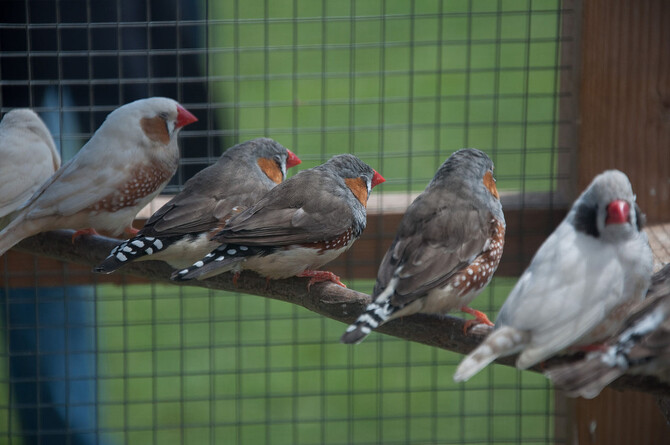Penn Researchers Investigate How Songbirds Teach Themselves Songs
Music can be a powerful form of expression. It’s especially important for songbirds such as zebra finches, which learn the songs of their fathers in order to court mates.
Until now, scientists have typically thought of the bird’s vocal development in terms of how one circuit in the brain learns a song. But a new study by researchers at the University of Pennsylvania investigated how zebra finches learn songs from a different perspective. Instead of looking at how the bird’s brain learns a song, they studied how one part of its brain, which they dubbed the “tutor,” teaches another part of its brain, the “student.”
The researchers found that in order to teach effectively, the tutor must adapt its teaching style to how the student best learns. The study, titled “Rules and mechanisms for efficient two-stage learning in neural circuits,” appeared today in the journal eLife.
The research was led by Vijay Balasubramanian, a physics professor in Penn’s School of Arts & Sciences, and Tiberiu Teșileanu, a visiting scholar whose main appointment is at the City University of New York Graduate Center. Bence Ölveczky, a professor of organismic and evolutionary biology at Harvard University, also contributed to the study.
One can think of the bird’s learning process as a musician learning a piece on the violin: After practicing the song over and over again until it sounds right, playing it becomes second nature to the violinist.
In the case of zebra finches, the bird hears the song, remembers it, sings it back and continues to adjust it over a period of about a month until it sounds right. As the bird sings, it learns to control its syrinx, the animal’s vocal organ, and its respiratory muscles.
“They start out babbling, and then eventually this congeals into trills and phrases and sounds like a song,” Balasubramanian said.
The key to this learning is that synapses in the brain strengthen or weaken based on one’s experiences of the world. Much of the focus in the field has been on learning rules, how these synapses change strength. An example of this is the Hebb rule, which says that two neurons firing coincidentally at the same time will strengthen their synapse.
But often, said Balasubramanian, one bit of the brain has to teach another bit of the brain how to do something. So when the student part of the brain is learning how to sing a song, the tutor part has to tell it whether the song it produced was good or bad and give instructions on how to improve. The researchers decided to focus on these teaching rules.
There are many different learning styles the student playing the violin might have. Some people are auditory learners; others are visual learners. Depending on the style of learning, different kinds of teaching may be more or less effective. The researchers found that the same is true in the brains of songbirds: Based on the synaptic plasticity rules, which are the learning rules used by neurons, different types of teaching rules in the brain will be more effective.
“Depending on how the neuron changes its strength of connections,” Balasubramanian said, “the teaching signal coming from another place should be adapted to the area of the brain that's trying to learn, in such a manner as to help it learn well. In this paper, we worked out good teaching rules, or how the teacher should adapt to the student to teach it well, and used them to try to make some predictions about how learning would work in the song-learning system of the bird.”
He said that in some situations the teacher should correct the errors of the student immediately as they occur. In other cases, the teacher shouldn’t correct things instantaneously but should take the long view of whether the student is doing well and correct the overall performance.
“There are these different modes of sending corrective signals depending on the nature of the learning rule used by the student,” said Balasubramanian. “If you mismatch it, the learning circuit in that part of the brain will do really badly.”
Balasubramanian and Teșileanu used data compiled by Ölveczky from recordings of neurons in different areas of the birds’ brains: the student area RA, the teacher area LMAN and the “conductor” area HVC, which counts the beats for the bird. They used this data to come up with a general mathematical framework that would apply to this data set and possibly others.
The researchers tried to figure out how the tutorial should be adapted to the student and to understand the system at various levels.
“Modeling the brain, or any other system, is best done at several scales,” said Teșileanu. “If you want to describe a tennis racket hitting a ball, for example, you wouldn’t just study it at the scale of atoms and quantum mechanics. In the brain, you don’t want to always go down to the neural level to figure out what’s going on; you might want to understand different levels in the hierarchy.”
The researchers hope to think about this idea of matched learning and teaching in mammalian brains and cortical networks, which allow learning of motor function. Learning, Balasubramanian said, doesn’t just involve the student. It also involves the teacher. It’s important to understand the roles of both of these areas of the brain.
“Over eons, structures in the brain have adapted to each other to produce function,” he said. “I suspect it’s just the case that brain areas are adapted to send messages to each other in ways that make themselves work well. I think it’s a new handle or lever for investigation to think about that: How a tutor area of the brain should structure its signals so that a student area can profit from the signal as best as possible given its constraints and its learning rule.”
The research was funded by the Swartz Foundation and National Science Foundation.








